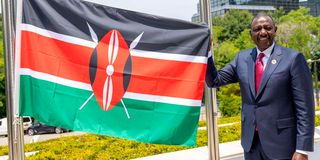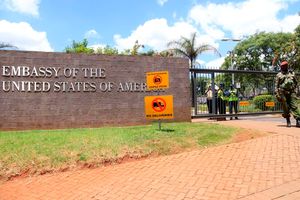
President William Ruto displays the Kenyan flag in Seoul, South Korea.
If you study the wider East African region from Nairobi, chances are you’re watching the economic rivalry between Kenya and Tanzania. It’s an emotive issue. Any time a report suggests that Tanzania might soon overtake Kenya economically, it triggers a storm of furious posts on social media—especially on X.
On March 8, 2023, Tanzanian President Samia Suluhu Hassan caused a stir when she boasted that Tanzania was economically stronger than its East African Community (EAC) neighbours. She said Tanzania had enough foreign exchange reserves to cover four months of imports, while a neighbouring country—widely interpreted to be Kenya—had approached it for assistance to secure fuel imports, having only two weeks’ worth of dollars in reserve.
Almost gloating, Suluhu declared: “Right now, every country is complaining of dollar shortages while we have enough to last us four months. We are getting requests to guarantee their oil supplies, but we have just been pretending that the situation is bad for us as well.” She added, “When they come to us for help, I tell them we are in the same situation, although our economy is stronger.” Social media had a field day. And Kenya lived to have the last laugh.
For those obsessed with the Nairobi–Dar es Salaam axis, reports from April 2025 that Kenya is set to overtake Ethiopia—and reclaim its spot as East Africa’s largest economy—might have come as a surprise. Few pay attention to the Nairobi–Addis Ababa rivalry, save for long-distance running.
Yet Ethiopia’s economy has been larger than Kenya’s in recent years. According to International Monetary Fund data, Ethiopia overtook Kenya around 2022. In 2023, Ethiopia’s GDP hit $126.2 billion, compared to Kenya’s $117.6 billion, buoyed by 7–10 per cent annual growth and a population of 126.5 million—twice Kenya’s.
Kenyan shilling appreciated
However, Kenya is set to retake the crown in 2025, with a projected GDP of $132 billion, while Ethiopia’s falls to $117 billion. This turnaround is largely due to the Ethiopian birr’s devaluation by over 55 per cent in July 2024, which slashed Ethiopia’s GDP in dollar terms. In contrast, the Kenyan shilling appreciated by 21 per cent, making it one of the world’s best-performing currencies in 2024. So how does Kenya, dogged by governance scandals and divisive politics, pull this off?
The paradox is that Kenya’s messy pluralism is part of the answer. Unlike Ethiopia’s centralised, state-driven model, Kenya’s more diversified economy—where services accounted for 69 per cent of 2023 GDP growth—absorbs shocks better. Its tech-financial sector continues to punch above its weight. Nairobi’s “Silicon Savannah”, though past its hype peak, still pulls in tech giants. The International Finance Corporation’s $1.4 billion portfolio in Kenya in 2025 dwarfs Ethiopia’s foreign direct investment (FDI) in manufacturing.
Ethiopia, however, is no pushover. Take just infrastructure where its ambitions are huge. The Grand Ethiopian Renaissance Dam is the largest hydroelectric project in Africa and among the 20 largest globally. Its upcoming $7.8 billion Bishoftu airport is expected to feature four runways and a terminal for 60 million passengers by 2029 and become Africa’s largest airport.
Ethiopian Airlines is the continent’s leading and most profitable carrier, serving 136 destinations. Kenya Airways, which had suffered years of losses until recently, serves 53. Ethiopia’s industrial parks still hum. Its demographic edge is real. But its top-down governance model lacks the sheer audacity of its southern neighbour.
Chaotic democracy
Additionally, Kenya’s chaotic democracy should be a handicap. Scandals like the $2 billion Eurobond saga and the 2024 Finance Bill protests point to deep dysfunction. Yet it fosters innovation. Unlike Ethiopia’s central planning, Kenya’s political frictions allow the private sector space to experiment. Where bureaucracy stalls, hustlers improvise. The elite are greedy. The streets are restless. But somehow, it works. Kenya wins ugly. But it wins.
Its hub status is one of its secret weapons. Mombasa port, essential for landlocked countries like Uganda, Rwanda, eastern DRC, and South Sudan, handles 1.6 million twenty-foot equivalent units (TEUs) annually—more than Dar es Salaam’s 1.2 million. Ethiopia remains landlocked.
Kenya also recently hit the diplomatic jackpot. By the end of 2026, three major UN agencies will relocate large parts of their operations from New York to Nairobi, joining UNEP and UN-Habitat. With over 4,000 new UN staff expected, Nairobi’s real estate, hospitality, and service sectors will get a major boost.
But Kenya’s lead is fragile. Tanzania’s disciplined growth and Ethiopia’s demographic heft loom large. Nairobi must tackle corruption and invest in human capital. Tanzania’s port upgrades and Uganda’s oil pipeline threaten Mombasa’s dominance. Rwanda is betting on digital innovation.
Still, no other country in the region combines all the elements quite like Kenya. Its hub status gives it a head start—but complacency could easily cede the ground.
The author is a journalist, writer, and curator of the Wall of Great Africans. X@cobbo3










